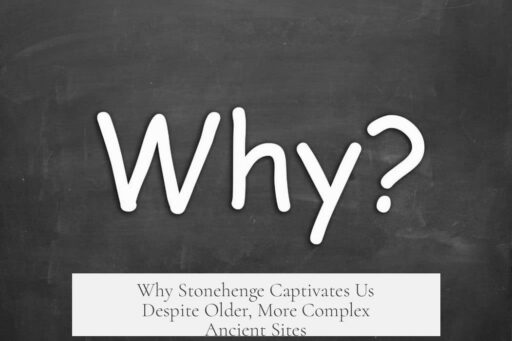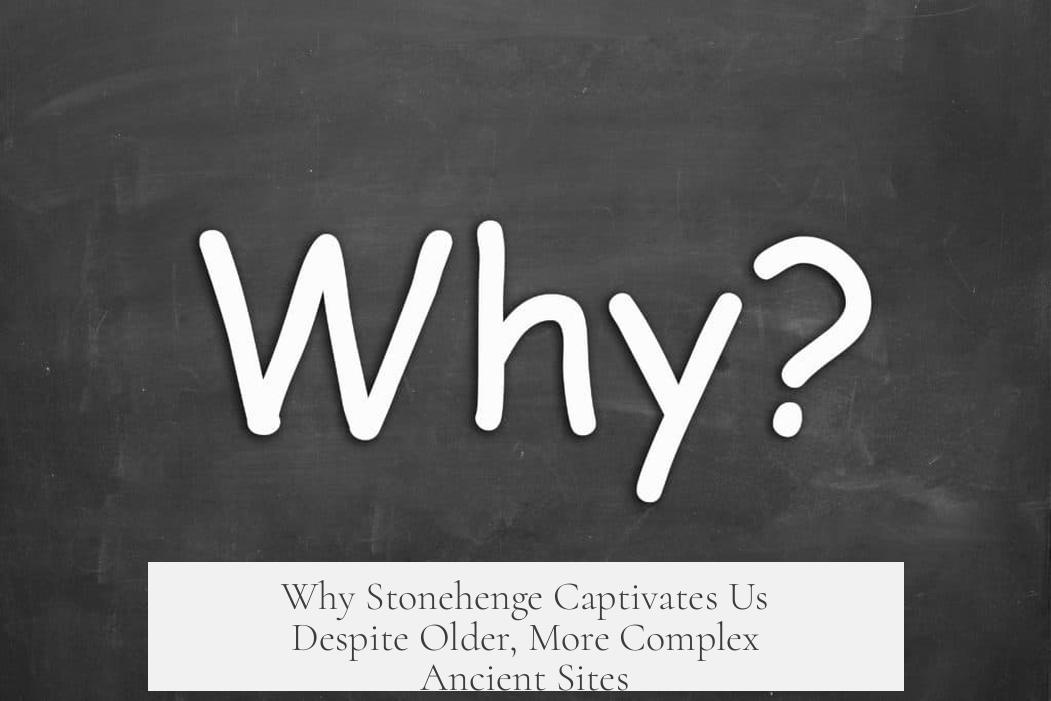People care so much about Stonehenge despite the existence of older and more complex ancient sites like Brú na Bóinne because Stonehenge combines architectural sophistication, archaeological prominence, cultural symbolism, accessibility, and sustained public interest. Its unique prehistoric context, construction feats, heritage narratives, and modern engagement secure its leading role in global heritage consciousness.
Stonehenge is not an isolated monument. It lies within a vast prehistoric landscape filled with barrows, earthworks, and other ancient structures. This setting includes the massive Durrington Walls henge and the cursus, which stretches several kilometers. Such integration highlights Stonehenge as a former cultural and ceremonial hub. Its importance stems from being part of this wider ancient complex rather than just the stone circle itself.
Architecturally, Stonehenge stands out as the most sophisticated prehistoric stone circle worldwide. It features massive Sarsen stones weighing up to 35 tons, sourced locally, and smaller bluestones transported over 250 kilometers. The logistical challenge of moving and arranging these stones reveals a remarkable level of ancient organizational skill and societal complexity. Few other ancient sites match this effort in construction.
Astronomical alignments add layers to Stonehenge’s mystery. The monument aligns precisely with the midsummer sunrise, where the sun rises near the Heel Stone and centers within the circle. Some researchers propose that its features could predict lunar eclipses. These celestial connections deepen scholarly interest and public fascination. This complexity is often less evident or less emphasized at other prehistoric sites.
Stonehenge’s archaeological research history also enhances its profile. It has engaged historians and scientists for centuries, including famous early scholars such as John Aubrey and William Stukeley. Their work embedded Stonehenge deeply into UK cultural consciousness. Continuous scholarly focus over hundreds of years fuels ongoing fascination and popular narratives.
Physical conservation and visitor infrastructure play crucial roles in Stonehenge’s fame. Restoration efforts during the 20th century stabilized and, in some cases, restored parts of the stone circle, making it more visually impactful. The site’s accessibility benefits greatly from its proximity to London, excellent visitor facilities, clear information, and well-maintained pathways. This contrasts with many ancient sites, which remain difficult to access and under-explained, reducing public awareness and engagement.
Heritage involves social and cultural meaning as much as historical facts. People construct stories and shared identities around Stonehenge, influenced by mythology, nationalism, and current cultural use. The narratives linking Stonehenge to Merlin, Druids, and other legends contribute to its enduring allure. These stories nurture emotional and cultural attachment that purely older or more complex sites might lack in popular imagination.
National identity and political promotion shape Stonehenge’s status further. The site serves as a symbol of Britain’s deep past, scientific achievement, and mystical heritage, making it a powerful emblem. Government bodies like English Heritage and the National Trust have managed and promoted Stonehenge since the early 20th century, ensuring its protection and public profile. This official backing contrasts with less institutional support seen at many other sites.
Economically, Stonehenge functions as a major heritage and tourism enterprise. Income generation through entrance fees and merchandising stimulates aggressive promotion. The 1986 designation as a UNESCO World Heritage Site added international recognition, boosting its global image. Financial incentives drive continuous marketing, which keeps Stonehenge at the forefront of public attention worldwide.
Social and cultural activities continue to sustain interest in Stonehenge. Since the 1960s and 70s, it has hosted countercultural events and New Age festivals. Contemporary Pagans and other groups regularly gain access during solstices, linking modern spiritual practices to the ancient site. This living cultural dimension contrasts with older sites that may lack active participation today.
| Factor | Stonehenge | Other Sites (e.g., Brú na Bóinne) |
|---|---|---|
| Age and Complexity | Less old but architecturally sophisticated | Older, often architecturally complex |
| Archaeological Research | Extensive, centuries-long, high profile | Often less publicized or researched |
| Restoration and Access | Restored, visitor-friendly, near London | Limited restoration, challenging access |
| Heritage and National Identity | Well-established national symbol | Less embedded in national mythos |
| Media and Economic Promotion | Strong marketing and global brand | Minimal international promotion |
| Ongoing Cultural Use | Active in modern rituals and festivals | Less associated with contemporary practices |
- Stonehenge stands out through its integration in a rich prehistoric landscape, advanced architecture, and complex astronomical orientation.
- Continuous archaeological study over centuries increases public and scholarly interest.
- Restoration efforts and excellent visitor facilities make it accessible and impressive today.
- Cultural narratives and national identity elevate it beyond a mere ancient monument.
- Heritage marketing, UNESCO status, and economic incentives build global recognition.
- Modern cultural practices ensure Stonehenge remains relevant and alive in public imagination.
Why Do People Care So Much About Stonehenge When There Are Older, More Complex Ancient Sites Like Brú na Bóinne?

People care about Stonehenge so much because it is not just an ancient stone circle; it is a cultural icon deeply woven into the fabric of British heritage, history, and identity, amplified by extraordinary archaeology, restoration, accessibility, and global recognition that older sites lack. But that’s only the start of the story. Let’s unpack why Stonehenge commands such attention compared to other ancient marvels like Brú na Bóinne in Ireland.
For context, Brú na Bóinne, home to the famous passage tombs of Newgrange and Knowth, dates back over 5,000 years—making it older and arguably more complex in some ways. So why hasn’t it captured global imagination quite like Stonehenge? The answers are multi-layered.
Stonehenge: More Than a Ring of Stones
The secret begins in the landscape.
Stonehenge does not stand alone. It is part of a sprawling prehistoric ritual landscape in Wiltshire, England, stretching at least 3 kilometers. This includes the enormous Durrington Walls henge—one of the largest Neolithic settlements in Britain—barrows, tombs, and earthworks that collectively form a vast cultural hub.
Unlike sites that feel isolated or singular, Stonehenge sits at the center of a network of ancient activities. This integration intensifies its cultural and ceremonial significance. Ancient peoples invested enormous effort crafting this whole environment, making Stonehenge the *focal point* of a larger sacred tapestry.
By contrast, while Brú na Bóinne’s tombs are architecturally complex and older, their spread across the landscape gives a different feel—more like a collection of marvels rather than a single stage for mass prehistoric ritual life.
The Architectural and Astronomical Wow Factor

Stonehenge fascinates partly because of its sheer engineering audacity.
The giant Sarsen stones, weighing between 25-35 tons, come from just 20 miles away. The real kicker: the smaller bluish stones weigh 2-5 tons and were transported over 250 kilometers from the Preseli Hills in Wales. Imagining a prehistoric crowd moving these giants without cranes or trucks baffles the modern mind.
Indeed, it reveals a society with logistical skills and social organization far beyond what was once assumed for Neolithic people.
Moreover, Stonehenge’s precise alignment with the midsummer sunrise and likely lunar eclipse markers adds mystery and sophistication. Gerald Hawkins famously proposed that the Aubrey holes acted as eclipse predictors—an ancient astronomical calendar etched in stone.
While Brú na Bóinne’s Newgrange features an astounding alignment to the winter solstice sunrise lighting the tomb’s inner chamber, Stonehenge’s broader astronomical and architectural intricacies across its huge scale contribute to its legendary status.
The Power of Archaeological Attention and Restoration
Stonehenge has enjoyed centuries of scholarly fascination, thanks in part to early antiquarians like John Aubrey and William Stukeley, who first studied and promoted the site. Continuous archaeological research has kept Stonehenge in the academic and public spotlight for over 400 years.
In the 20th century, restoration efforts literally raised the stones and preserved the monument, making it visually imposing and safer for visitors. Compare this with Avebury—the largest prehistoric stone circle—which lacks similar restoration, limiting public appreciation despite its size.
Furthermore, Stonehenge boasts first-class visitor facilities, just two hours from London, with wheelchair access, informative centers, and easy pathways—all boosting its accessibility. In contrast, many ancient sites like Brú na Bóinne are tucked away in rural or less accessible settings, sometimes reduced to farmer’s fields with minimal interpretation.
Heritage, Identity, and the Stories We Tell

Here’s where things get really interesting.
Stonehenge’s significance is partly built on something historian Laurajane Smith calls “heritage as a social and cultural construct.” While history sticks to facts, heritage is all about what people choose to celebrate, mythologize, and embed with meaning.
Communities weave stories around Stonehenge, turning it into a living symbol. Legends ranging from Merlin the wizard summoning stones to ancient Druids crafting the circle shape its popular imagination.
This mythmaking attracts not only tourists but also spiritual practitioners. Since the 1960s and 70s, Stonehenge has been a magnet for counterculture movements and New Age religions. The annual summer solstice gathering, where modern Pagans gain special access, refreshes public interest every year.
Brú na Bóinne, while steeped in its own myths, lacks the extensive countercultural and new spiritual phenomena that keep Stonehenge vibrant in modern times.
National Pride and Political Backing
Stonehenge’s iconic status also owes a lot to how heritage is used to craft national identity and political narratives.
Barbara Bender pointed out that Stonehenge has become a *national icon*—a symbol of a proud past. Governments actively support and manage the site through organizations like English Heritage and the National Trust, making Stonehenge a showcase for Britain’s ancient glory and cutting-edge research.
Early 20th-century heritage movements used Stonehenge as a test case for preservation and public education, reinforcing its towering profile in British culture.
In contrast, Brú na Bóinne, though a UNESCO World Heritage Site since 1993, receives less public investment in promotion and infrastructure, so its role in Irish national conscience is somewhat different.
The Business of Heritage and Global Branding

It might sound a bit cynical, but heritage is big business. English Heritage aims for Stonehenge not only to be preserved but also to generate income through tourism. This means marketing efforts and media coverage are intense, cementing Stonehenge as one of the world’s most recognizable ancient sites.
Stonehenge’s addition to the UNESCO World Heritage List in 1986 gave it international clout, making it an emblem not just of British history but of human cultural achievement on the world stage.
This global branding raises its profile far beyond what sites like Brú na Bóinne, despite their antiquity and complexity, can achieve.
So, What Can We Learn From This?
- Stonehenge’s Fame Is Multifaceted: Its significance comes from combined archaeological marvels, the scale of the prehistoric landscape, and active cultural story-building.
- Restoration and Access Matter: Visitors flock to sites they can easily reach and fully experience. Spectacular restoration creates a “wow” factor galleries and open fields cannot match.
- Stories and Symbolism Shape Our Interests: Legends, spiritual uses, and national identity are powerful magnets for public imagination.
- Publicity Fuels Popularity: Heritage organizations invest in marketing. UNESCO recognition boosts global recognition too.
- Older or Complex Isn’t Always More Famous: Brú na Bóinne’s age and complexity don’t guarantee the same prominence without similar cultural, political, and practical support.
What About Other Sites Like Avebury?
Avebury could rival Stonehenge’s fame, but only if it receives equivalent attention and restoration. Imagine the shortest road closed forever–the giant stone circle restored fully to its former glory. That alone might shift public affection.
Stonehenge’s case shows how a combination of factors, not just antiquity or complexity, creates heritage icons.
Final Thoughts
Stonehenge’s allure is no accident.
It’s the product of extraordinary prehistoric engineering, celestial mysteries, and an ongoing human conversation spanning centuries. Archaeologists, governments, spiritual communities, and tourists all play a part.
Meanwhile, sites like Brú na Bóinne quietly preserve earlier chapters of human history, waiting for wider appreciation beyond specialists and local pilgrims.
Next time you gaze at those towering stones, remember: you’re looking not only at an ancient enigma but at a dynamic story of culture, myth, politics, and passion. That’s why people care so much about Stonehenge—because it is more than stones; it’s a living symbol of human connection to the past.
Quick Visitor Tip:
If you want a fuller prehistoric experience, consider visiting both Stonehenge and Brú na Bóinne. Marvel at Stonehenge’s massive stones and ritual landscape, then traverse into Ireland’s Boyne Valley to explore Newgrange’s dazzling winter solstice illumination. Both reveal different facets of our ancient world’s brilliance.
Curious what it feels like to stand inside an ancient landscape pulsing with stories millennia old? Both sites offer profound, if distinct, encounters. Which story do you want to be part of?




